ENTER YOUR EMAIL TO RECEIVE OUR WEEKLY NEWSLETTER
I am a Camera (American-Style)
A former high school English teacher recounts her life-changing, midlife photography career
By Debbie L. Rubin
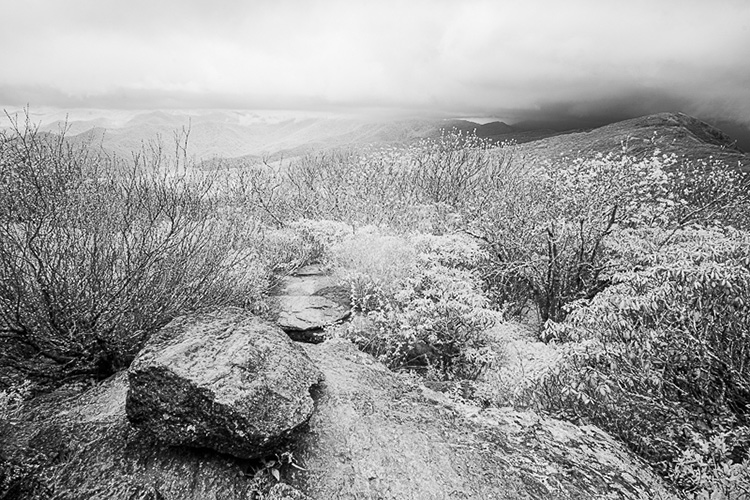
Alligator eyes twinkling in the pre-dawn … snakes slithering across my path … bears, deer, and sometimes bobcats accompanying me on my early morning shoots. I’m grateful for their presence. I send them wishes to find something or someone better than me to feast on—and then I ignore them. There’s a positive balance to these predatory creatures—a very comforting quietude. I hear the croaking of frogs, dragonflies skimming across the lake, birds awakening one another with tentative chirps. It is at that moment when sunshine begins to burst through the forest, when its gradations of light, so appealing to me, begin to appear. Daylight photography time has arrived.
Having grown up in Oceanside, Long Island, with its seashore and dunes, and then marrying and moving to the city of Utica in Upstate New York, I replaced the ocean with mountains and lakes. Once again, in 1986, when our kids were eight, nine, and 12, and I had a career as a high school English teacher, we made a major, major move—southward, to Fort Lauderdale. There, I got to see the gifts that Florida had to share. I had read Patrick Smith’s book A Land Remembered, which gave me foresight into the many wonders that I soon began experiencing. It was finally, once I was living them, that I realized my passion for creating stories through visual images—and the desire to share them with others.
This was the beginning of my photography career. I was always aware of my desire to write creatively, but to add another layer through photography, using all my senses—that was captivating.
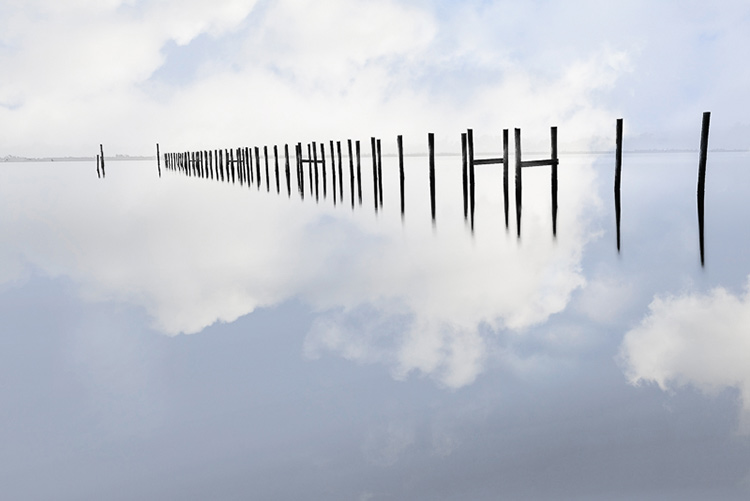
It was in Florida that I learned the importance of rising before dawn (on many days as early as 2 a.m.) to travel several hours so I could arrive at my destination—a garden where I could set up my camera before sunrise, or a swamp with an alligator and water moccasins (though the latter were unseen). And to accomplish this, I’d often wear hip boots, waders, and/or a mosquito suit—my version of the Dress for Success suit.
Rarely, one or more members of my family have accompanied me on these excursions—but only if they are interested in a particular setting. My husband Lew finally gave up when I asked him to wait on shore while I climbed on a log and made my way to the middle of a swamp. He was very patient, which was all well and good. But when I returned, some nearby hikers stopped us, asked if I had been in the water (as they surely surmised, with me wearing those hip boots), and then advised us to look across the way at an alligator, about 11 feet long, on the opposite shore—hardly 15 feet from where we were standing. That was when Lew announced that he had no further desire to encourage me by tagging along. Well, we’ll see about that, I figured.
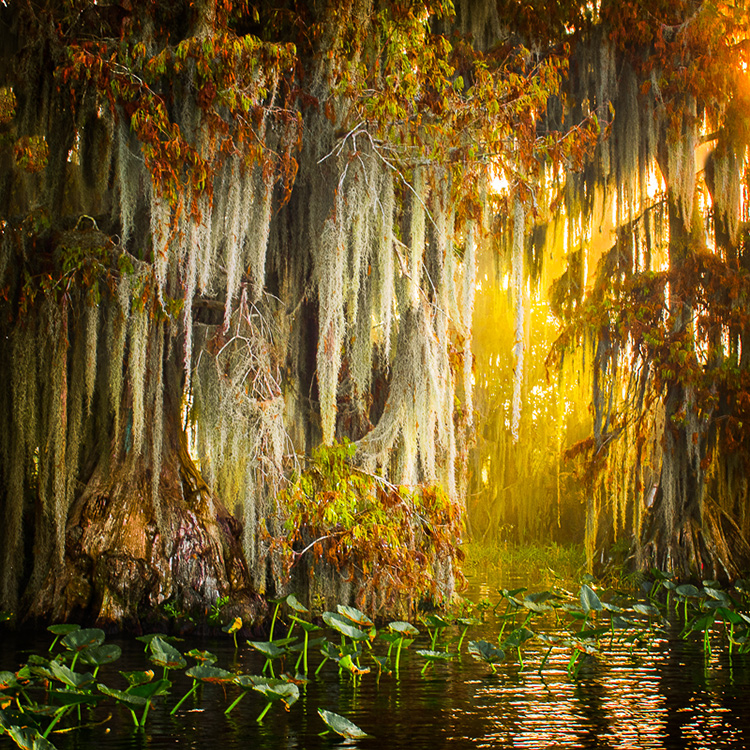
As for our three children, now grown up—they understand, as do our grandchildren, that if they want to come along with me, they must bring their patience with them. Lew really understands too. Despite all his concerns, he is my greatest champion and often must be hushed while expounding on the photographic awards I’ve won.
Having had a career running a telecom enterprise, Lew favors the left side of his brain; I indulge my right side. So we’ve always worked independently of each other. But it’s wonderful to share our views. And now that he’s retired and more and more in relaxation mode, I do manage to bring him along on my explorations—maybe more often than I should!
After 14 years in Florida, we recently made yet another major, out-of-state move. Our children and grandchildren wanted to live in the mountains, where they could engage in water sports on a high-altitude lake. That brought them to North Carolina. And after several years of renting homes in varying locales there, they found a town and a home in that beautiful state that proved perfect for us, as well. We joined them while retaining our place in Fort Lauderdale. I fly back to Florida for an occasional shoot in the beautiful rivers, streams, and ocean replete with exquisite birds in surroundings with oak hammocks. I return to my mountain home to forest-bathe, hike, and luxuriate around the mountains cocooned in the clouds, where I continue communing with nature. I bring it all together in my landscapes, hoping to create visual stories that are both stimulating and inviting.
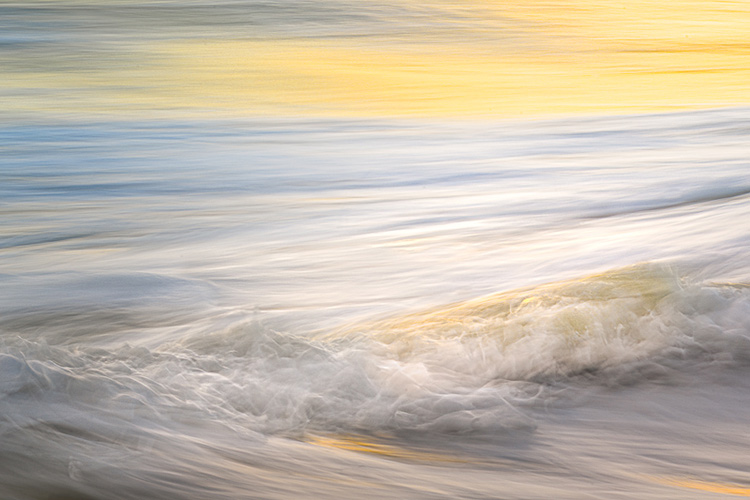
So, my photography career is now focused on two very different states—one inland, the other coastal. In Florida, where the light is vibrant, and sometimes misty, and most of the time the air is humid. In North Carolina, where the light is either cocooned in fog weaving through the mountains or brilliant with an autumnal palette that’s both stimulating and inviting. But no matter where I am, it all comes down to lighting—whether I want a silhouette against a sundrenched sky or a mountain shrouded in the mist, emerging from a body of water and the shadow it creates.
My camera career, which got under way when we settled in Florida, was renewed when we went on safari in Africa. What better 60th birthday present could there be for someone like me, with a penchant for adventure? Traveling in open-air jeeps, witnessing elephants, lions, and giraffes, among a multitude of other wildlife—that was sensory overload for me. My teaching career was of extraordinary help here. I recalled instructions I gave my students about developing a descriptive composition, having a clear-cut picture of whatever they wanted to express. I incorporated this using visible subjects, adjectives, adverbs which come together in a pictorial composition. A subject such as a cabin, surrounded by trees, a bird flying overhead, and in the foreground a pile of firewood—these cohere for a perfect composition.
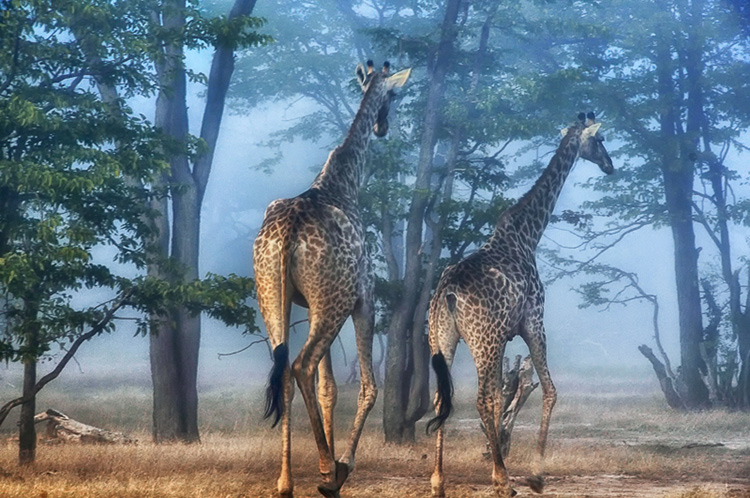
Traveling through Zimbabwe, Zambia, Botswana, and South Africa, including a visit to Robben Island Prison, off Cape Town, I was in constant awe. It was as if I had stepped into one of my fantasy images and experienced literal magic. And then in the villages we visited, I was able to take a step back to a time unspoiled by modern commerce. Here was a different side to humanity, setting up a duality in me—my life in the U.S. versus that of the many Africans we found, living in makeshift homes of clapboard and tin, making the best of things while their children ran around shoeless while playing street games. It seemed to me that these communities were oblivious of what they did not have.
The children at the schools we visited wanted to have their pictures taken, so they could view them on my camera’s LCD screen. One of the families we visited in South Africa left a longstanding impression on me. They encouraged me to take images of their lovely home and of their teenage daughter studying for school, while their teenage son, in the background—seemingly bent on not smiling and not doing his homework—showed contempt for the intruders in his home. It was a clear-cut division of what was going on at the time. We had noticed a lack of commitment in the men, both in the cities and the country. The women basically complained that family responsibilities were up to them. They worked and worked hard as the support-givers, providing the essentials and love to the children, while the men were more or less on their own.
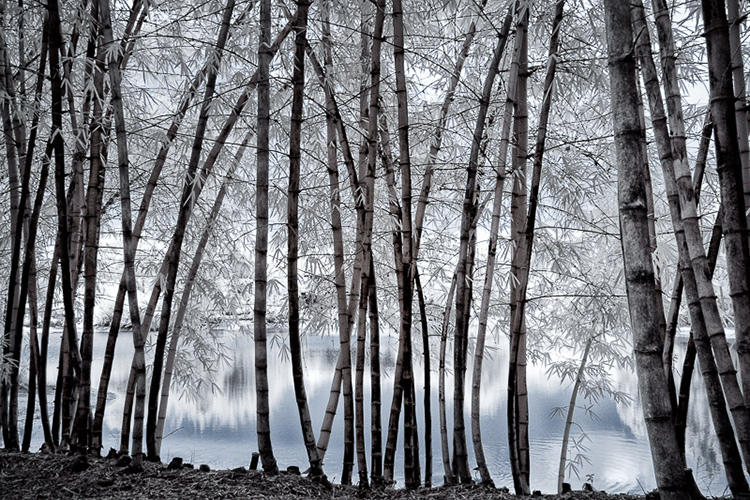
On our return to Florida, I enrolled in photography critique classes at the Boca Raton Museum and at Old School Square in Delray Beach, where I worked my way up from beginner to masters. I met others who shared my interests, and we became dear friends and fellow travelers. And travel I did—and continue to do—to states like Maine and California. I always look for the unique setting or subject, staying away from familiar, iconic sights. I love the folklore of different countries, as well, and try to incorporate it in my photography. A fairy or a leprechaun-like figure in a forest certainly enhances the landscape of Ireland. The trolls and mythical sea creatures and multitude of elves that are part of the charm of Iceland—these too inspire my work. I talk to the locals and learn their legends. Often I find trees that resemble fairies or trolls; these get worked into my compositions. One of my experiences in Iceland brought me to the top of a cliff—despite my being frightened of heights. But there I was, sitting down, waiting for the light to enhance my scape, when something or other tapped me on the shoulder. I jumped—there was no one else around—wondering if that something was a troll. It turned out to be a woman warning me not to sit there, as one of the trolls was likely to come by and push me off! Was she perhaps a troll in human form? Yes, this is how my thinking wanders when I’m on a shoot.
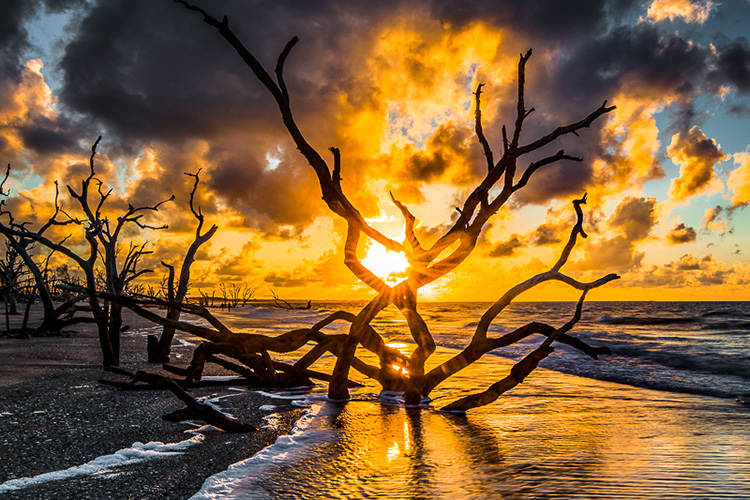
I photograph with Nikon Z 7-2 cameras, as well as Nikon Z lenses. I have several of these—a 14-24mm, a 24-70, a 24-120, and a 100-400—as well as filters and a macro lens. To keep the weight of my gear down, I switched from DSLR to mirrorless cameras. In addition, it’s not unusual for me to use a converted infrared camera, which lets me shoot in black and white, allowing organic material to turn white, emulating snow or negative space.
Sometimes I see in black and white, sometimes in color, depending on the emotion the moment brings to me. It gives me great joy to create a meaningful image that causes the viewer to feel strongly for the subject or want to step into the composition simply to enjoy the moment. It is essential in knowing the exact moment to click the shutter to create what I hope will become the perfect provocative image.
Time doesn’t pass; it’s irrelevant to me when I’m shooting or editing—much to the chagrin of whomever may be waiting for me to finish! I can’t even go on an errand without my camera, as there is always something enticing for me to pull over and shoot.
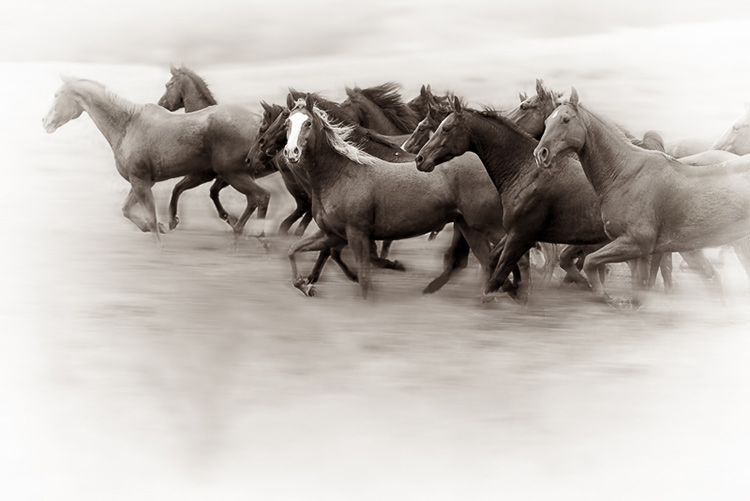
My muses come in many forms. A couple of the photographers I admire are Ansel Adams, who created the tonal range of photography, and that wonderful black-and-white street photographer-turned-painter, Henri Cartier-Bresson. I also find painters to be a major source of my motivation. Monet, the mid-20th century Florida Highwaymen, and other Impressionists—these breakthrough figures have greatly influenced my photograph choices. Nature is a given—the best stimulus for my photographic art.
Of course, having a successful career does not come without frustrations and setbacks. They include failures, from which we grow. I spent several years in Florida developing my craft. I joined many groups and applied to an abundance of shows. Since photography is so very subjective, I find myself at the whim of those judging my work. It takes a while for any artist to create a name for her- or himself. I managed to develop my name in Florida—and then had to start all over again when we moved to North Carolina.
It also took time for me to realize the differences in the clientele here, as well as in the subject matter and framing. It went very smoothly at first because I was showing my work out of my home, where visitors were delighted to view it. I find it’s always easier to sell in such an established setting—and I ended up selling off my walls. But going from gallery to gallery was another thing. I had to transfer my thinking and images to “mountain mode,” and always to add wooden frames—even to my modern metal prints. The price points here are very different, as well, from those in South Florida.
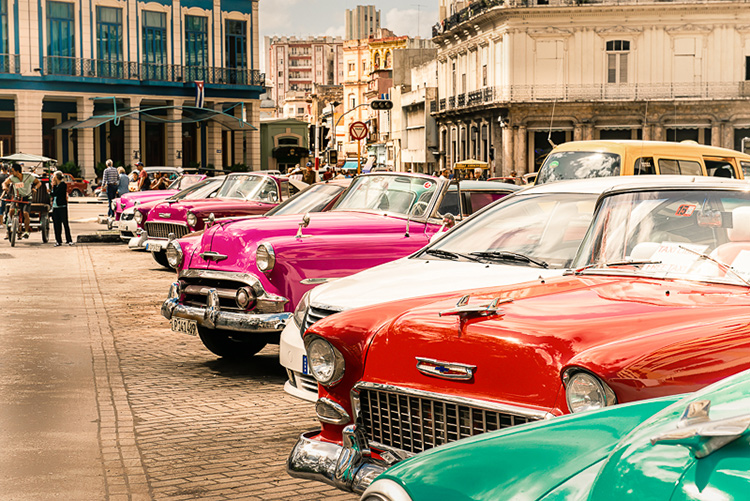
Another risk is the loss of motivation and finding it replaced with a feeling of staleness. That’s happened to me, and the remedy, I’ve found, is to take a break and refresh by looking for someplace new; I mosey around seeking any spark to ignite my senses.
There have been limitations to overcome, both here and in Florida. I’ve been attacked by mosquitoes to the point that my dermatologist thought I might have shingles instead of bites. I have a fear of snakes, which can be quite off-putting, both in the Florida swamps and among the copperheads around our home in North Carolina. I have been on shoots when I had to scale mountains with just a cable to hold onto while carting my equipment. My first trip to Oregon included a four-mile overnight trek lugging camping gear and cameras down onto a canyon beach, then setting up a tent, cooking over a Bunsen burner, and using the “open-air” facilities. What did a girl who was brought up brought up in Nassau County know about camping in the wilderness?
In addition to doing landscapes, I’m involved with photojournalism. While in Cuba, I not only photographed a lineup of meticulously preserved ’40s and ’50s American cars, but also some people hijacking wiring to avoid paying the power company. There, as well, I asked permission to photograph a man sitting on a wall by the sea—he’d lost a leg in a political fight. While in Lake Powell, in Utah and Arizona, I shot the power company polluting the beautiful surrounding land. That prompted a discussion with some locals about their sense of security in their homes. While I was in Africa and Cuba, opportunities arose for editorials not necessarily favoring pleasant pictures of happy locals. I believe exposés must be handled very carefully, without shaming anyone.
I wish to continue my journey to see where it leads. Next on my agenda? The Galapagos Islands, followed by Alaska. My love of wildlife and nature encourages my path.
Debbie L. Rubin’s photos can be found in various permanent collections, including those in Naples, FL at Skin Wellness Physicians; in Boca Raton, FL at the Philip & Harvey Sandler Center; and in Tryon, NC at Tryon Painters and Sculptors and the 86 Gallery. Visit her website, Debbie Lynn Photography.











